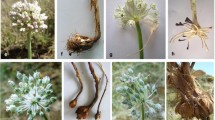Abstract
The relationship among members of the subgenus Phleum was determined using nuclear ribosomal ITS and chloroplast trnL intron DNA sequences. This subgenus is derived from a progenitor of the diploid Phleum alpinum subsp. rhaeticum. The relationships provide evidence of migration, hybridization, polyploidy and speciation associated with historical glaciations.
The subgenus Phleum represents one enormous germplasm pool for breeders and it should now be possible to re-synthesize hexaploid pratense from a wider range of diploid forms than occurred historically. This requires the urgent collection of genetic resources from the centers of diversity within glacial refugia as these resources are almost entirely absent from genebanks.
Access this chapter
Tax calculation will be finalised at checkout
Purchases are for personal use only
Preview
Unable to display preview. Download preview PDF.
Similar content being viewed by others
References
Cenci CA, Pegiati MT, Falistocco E (1984) Phleum pratense. (Gramineae): chromosomal and biometric analysis of Italian populations. Willdenowii 14: 343–353
Conert HJ (1998) Phleum. In: Hegi (Ed.) Illustrierte Flora von Mitteleuropa. I/3, Verlag Paul Parey, Berlin-Hamburgpp. 190–206,
Ellestrom S, Tijo JH (1950) Note on the chromosomes of Phleum echinatum. Botanical Notes 463–465
Ellison NW, Liston A, Steiner JJ, Williams WM, Taylor NL (2006) Molecular phylogenetics of the clover genus (Trifolium – Leguminosae). Molecular Phylogenetics and Evolution 39: 688–705
Heide OM, Solhaug KA (2001) Growth and reproduction capacities of two bipolar Phleum alpinum. populations from Norway and South Georgia. Artic, Antarctic, and Alpine Research 33: 173–180
Hewitt GM (1999) Post glacial recolonisation of European biota. Biological Journal of the Linnaean Society 68: 87–112
Hong , QWhite P, Klinka K, Chourmouzis C (1999) Phytogeographical and community similarities of alpine tundras of Changbaishan Summit, and Indian Peaks, USA. Journal of Vegetation Science 10: 869–882
Humphries CJ (1980) Phleum. In Tutin TC et al. Flora Europeaea 5. Alismataceae to Orchidaceae (Monocotyledones), Cambridge University Press, Cambridgepp. 239–241,
Joachimiak A (2005) Heterochromatin and microevolution in Phleum. In Sharma AK, Sharma A (Eds) Plant Genome: Biodiversity and Evolution. Vol. 1, Science Publishers., Enfieldpp. 89–117, Part B: Phanerogams, chapter 4,
Joachimiak A, Kula A (1993) . Cytotaxonomy and karyotype evolution in Phleum sect. Phleum (Poaceae) in Poland. Plant Systematics and Evolution: 188: 11–25
Joachimiak A, Kula A (1996) Karyosystematics of the Phleum alpinum. polyploid complex (Poaceae). Plant Systematics and Evolution 203: 11–25
Kula A (2005) Searching for a Primeval Phleum, karyotype. In Ludwick F (Ed) Biology of Grasses, Polish Academy of Sciences: Krakow, Poland
Kula A, Dudziak B, Sliwinska E, Grabowska-Joachimiak A, Stewart AV, Golczyk H, Joachimiak A. (2006)Cytomorphological studies on American and European Phleum commutatum Gaud. (Poaceae). Acta Biologica Cracoviensia: 4899–108
Maire RD (1953) Flore de L'Afrique du Nord. Fl. Afrique N.: 367
Nordenskiold H (1945) Cyto-genetic studies in the genus Phleum. Acta Agriculturae Suecana 1: 1–138
Nordenskiold H (1957) Segregation ratios in progenies of hybrids between natural and synthesizedPhleum pretense. Hereditas 43: 525–540
Soltis PS, Soltis DE (2000)The role of genetic and genomic attributes in the success of polyploids. Proceedings of the National Academy of Sciences of the United States of America 97: 7051–7057
Weber WA (2003) The Middle Asian Element in the Southern Rocky Mountain Flora of the western United States: a critical biogeographical review. Journal of Biogeography 30: 649–688
Zernig K (2005) Phleum commutatum and Phleum rhaeticum (Poaceae) in the Eastern Alps: characteristics and distribution. Phyton 45: 65–79
Author information
Authors and Affiliations
Corresponding author
Rights and permissions
Copyright information
© 2009 Springer Science + Business Media, LLC
About this paper
Cite this paper
Stewart, A.V., Joachimiak, A., Ellison, N. (2009). Genomic and Geographic Origins of Timothy (Phleum sp.) Based on ITS and Chloroplast Sequences. In: Molecular Breeding of Forage and Turf. Springer, New York, NY. https://doi.org/10.1007/978-0-387-79144-9_6
Download citation
DOI: https://doi.org/10.1007/978-0-387-79144-9_6
Publisher Name: Springer, New York, NY
Print ISBN: 978-0-387-79143-2
Online ISBN: 978-0-387-79144-9
eBook Packages: Biomedical and Life SciencesBiomedical and Life Sciences (R0)




